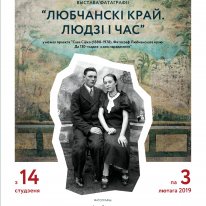“Lubchansk region. People and time” exhibition
- 14.01.2019
The second part of the exhibition is dedicated to the creative activities and interesting fate of this unique photographer Savva Sivko from the Lubchansk region.
The photographer was born in the village of Senno, which is 5 km away from the small Belarusian town of Lyubcha. During 7 years – from 1914 to 1921. – he was held captive in a camp for Russian prisoners of war in the German city of Ingolstadt (Bavaria). There, according to his nephew P. P. Sivko, he learned to photograph, cook cheeses and drive a tractor. In 1922–1923, Savva Sivko returned to his native village. From 1925 to 1930–31 he worked as a cheesemaker in one of the private estates near Ivye (at that time: Volozhinsky district, Novogrudok province), and his wife Yevgeny (Genya) sewed. It is then that he begins his photographic work. The earliest works of Savva Sivko can be seen in two frames, placed next to the biographical show–case. In 1931–32, Savva Vladimirovich returned to Senno and began his active photographic work – “capturing on camera” the residents of Lyubcha and the surrounding villages near 25–30 km region. During this period, photonegatives of schoolchildren began to appear en masse in villages of Lyubcha, Kupisk, Zagorye–Sennenskoe. Undoubtedly, photographic work for Savva Vladimirovich was not only a hobby, but also an additional income.
The chronological framework of this photo archive covers a very long period of time – from 1925 to the early 1960s. Most of the materials concern the period of 1932–1941. The collection is very diverse in its genre styles. It presents almost all the major genres, except for still–life. Portrait, perhaps, is the most common genre here. The collection contains more than six hundred portraits of Lyubcha residents and also the surrounding villages. Belarusians, Poles, Jews, Tatars, old people, children, teenagers, young men and women – all these are countrymen of Savva Sivko. He made these photos with great love at all moments of their difficult life, from birth to death.
The exhibition presents 1/6 of the unique photo archive by Savva Sivko – 170 photos. Albert Tsekhanovich, modern photo artist, made gelatin–silver prints from Sivko's photonegatives on photographic paper of the late 1970s – early 1980s (using the method of contact photo print). The entire collection, if desired, can be seen on TV monitor (ask the museum attendant).
The unique object was discovered in the attic of photographer's forsaken house – a painted photographic screen, which served as a background to perform portrait photography in the 1930s. There are no such items like this in Belarus. Yulia Dranets, a young fine art restorer of the museum, restored the screen at the expense of the grant by the President of the Republic of Belarus. It is one of the key exhibits and performs the same function – if you wish, you can take a picture against the screen sitting on chairs with family or friends.
During our museum trips to the Lyubcha region, we heard many touching stories about life of that time. You too can hear them with the help of audio guides – ask the museum attendant.
The second part of the exhibition, called "Lyubcha region. People and Time" starts on January 14, 2019 (from 5.00 pm). The exposition will be situated on the 2nd floor of the museum (Exhibition hall no. 12). The project curator – photo artist Albert Tsekhanovich.
For visitors
opening hours
Open: 11.00–19.00
Daily
Ticket desk open: 11.00 – 18.30
Visitors enter: 11.00 – 18.30
admission
Adults:
Permanent exhibitions tour –
Br 10 BYN
Guided tour –
Br 30 BYN
Full-time students:
Permanent exhibitions tour –
Br 8 BYN
Guided tour –
Br 25 BYN
Schoolchildren and specialised secondary school students:
Permanent exhibitions tour –
Br 5 BYN
Guided tour –
Br 15 BYN
Retirees:
Permanent excibitions tour – 5 BYN
Guided tour – 15 BYN
Contacts
12 Vulica Karla Marksa, Minsk, 220030, Republic of Belarus
+375 17 3237665
+375 17 3748322
+375 17 3654827
histmuseum@histmuseum.by
Scientific department
office@histmuseum.by
Museum reception









